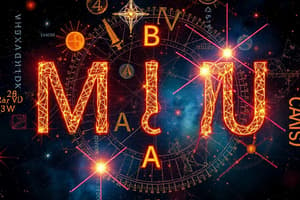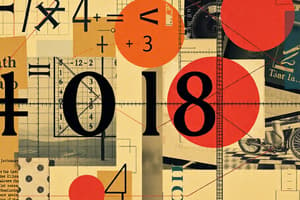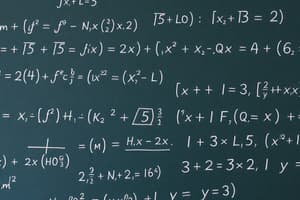Podcast
Questions and Answers
What is the primary function of mathematical symbols?
What is the primary function of mathematical symbols?
- To replace spoken language in mathematics
- To represent concepts, operations, and relationships (correct)
- To entertain readers during calculations
- To complicate mathematical communication
Which of the following is an example of a mathematical variable?
Which of the following is an example of a mathematical variable?
- π
- sin(x)
- x (correct)
- 5
How do mathematical symbols aid in abstraction?
How do mathematical symbols aid in abstraction?
- They make calculations longer and more complex
- They substitute for definitions of operations
- They allow mathematicians to focus on general ideas (correct)
- They serve no purpose in mathematical reasoning
What ensures unambiguous interpretations in mathematical language?
What ensures unambiguous interpretations in mathematical language?
What role do logical connectives play in mathematical statements?
What role do logical connectives play in mathematical statements?
Which mathematical symbol represents 'not an element of'?
Which mathematical symbol represents 'not an element of'?
What is a defining feature of mathematical proofs?
What is a defining feature of mathematical proofs?
What is the benefit of combining symbols and language in mathematics?
What is the benefit of combining symbols and language in mathematics?
Flashcards
Symbols in Math
Symbols in Math
Mathematical symbols are used to represent concepts, operations, and relationships.
Concise Math Communication
Concise Math Communication
Mathematical symbols enable concise and precise communication in mathematics.
Abstraction in Math
Abstraction in Math
Mathematical symbols help mathematicians work with general ideas rather than specific examples.
Precise Definitions in Math
Precise Definitions in Math
Signup and view all the flashcards
Rigour in Math Language
Rigour in Math Language
Signup and view all the flashcards
Mathematical Proofs
Mathematical Proofs
Signup and view all the flashcards
Connection of Symbols and Language
Connection of Symbols and Language
Signup and view all the flashcards
Combined Power of Symbols and Language
Combined Power of Symbols and Language
Signup and view all the flashcards
Study Notes
Symbols in Mathematics
- Mathematical symbols represent concepts, operations, and relationships. They are essential for concise and precise communication.
- Symbols facilitate abstraction, enabling mathematicians to deal with general ideas instead of concrete examples.
- Examples of fundamental symbols include:
- = (equality)
-
- (addition)
- − (subtraction)
- × or ⋅ (multiplication)
- ÷ or / (division)
- ≠ (inequality)
- < (less than)
-
(greater than)
- ≤ (less than or equal to)
- ≥ (greater than or equal to)
- √ (square root)
- π (pi)
- ∈ (element of)
- ∉ (not an element of)
- ∪ (union)
- ∩ (intersection)
- Symbols can be combined to create complex expressions and notations. For example, 2 + 2 = 4 uses several symbols to communicate a specific mathematical statement.
Language in Mathematics
- Mathematical language, though specialized, shares some elements with everyday language.
- Mathematics relies heavily on precise definitions to ensure unambiguous interpretations of concepts.
- Precise definitions form the basis for logical reasoning.
- The language is structured using axioms and postulates that provide the framework.
- Mathematical statements utilize logical connectives like 'and,' 'or,' 'if...then,' and 'not.'
- Vocabulary includes:
- Variables (e.g., x, y, z)
- Constants (e.g., π, e)
- Functions (e.g., f(x), sin(x))
- Sets (e.g., {1, 2, 3})
- Mathematical language is rigorous, adhering to logical rules. Invalid statements are not considered part of the mathematical language.
- Mathematical proofs are structured arguments based on logical premises to reach a conclusion.
- This rigorous language is essential for:
- Accuracy and clarity in communication
- Building strong foundations for further mathematical concepts
- Defining terminology and rules within specific mathematical areas
- Developing and supporting mathematical arguments
Connection Between Symbols and Language
- Mathematical symbols and language are interconnected. Symbols represent complex verbal descriptions concisely.
- The formal language utilizes precise symbols to represent relationships and ideas, facilitating the expression of complex mathematical concepts.
- Symbols and language are combined to express complex ideas, making calculations easier and improving logical reasoning.
- The combined symbolic and linguistic structure in mathematics facilitates:
- Improved communication of complex ideas
- Precision in statements and arguments
- Efficient creation and understanding of mathematical problems and solutions.
- Mathematical symbols are widely used across various mathematical fields, each with unique notations.
Studying That Suits You
Use AI to generate personalized quizzes and flashcards to suit your learning preferences.




